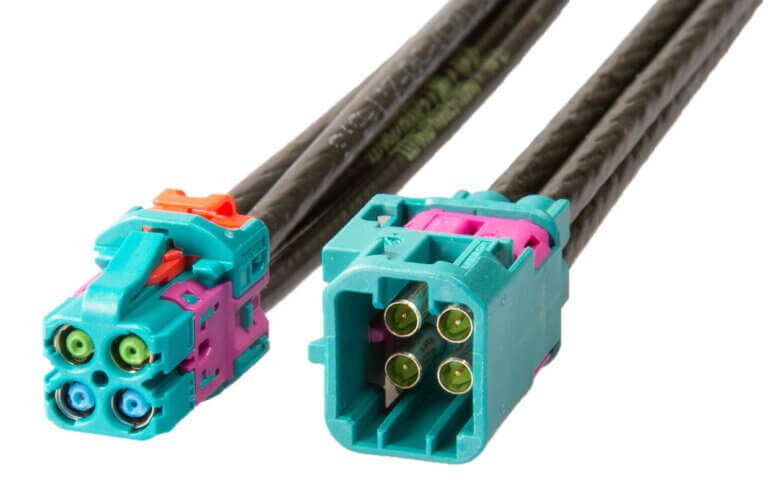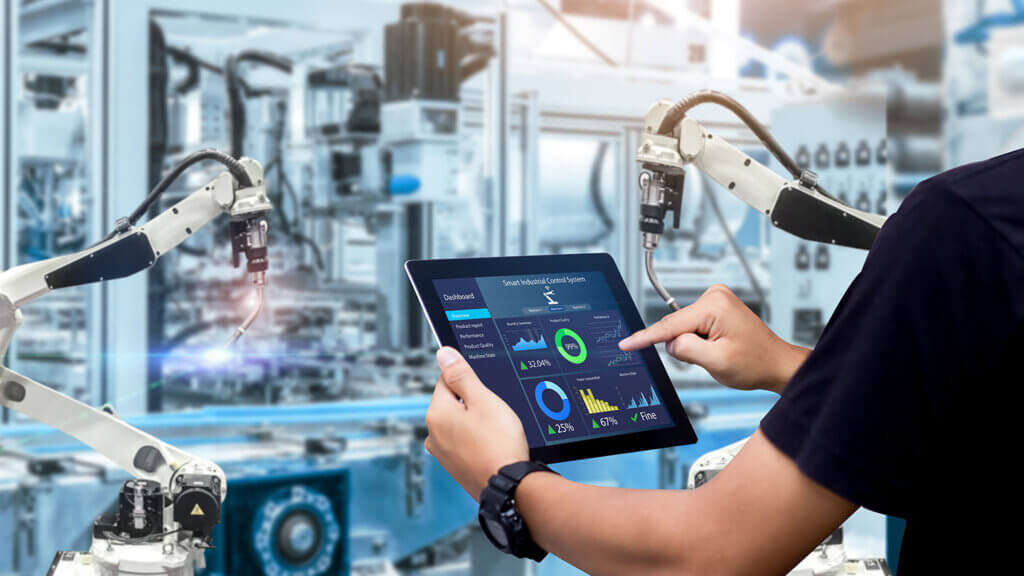Sustainability is more than just a buzzword. In the automotive industry it unlocks opportunities for innovation, new business models, and environmentally friendly mobility, while safeguarding long-term competitiveness. Modern wiring system technologies are the nervous system of connected and increasingly autonomous vehicles and thus a core element of sustainable mobility concepts. This is not limited to vehicle operation: the wiring system itself offers substantial potential. Optimized concepts, innovative materials and energy-efficient production methods are shaping the evolution of modern E/E architectures. A holistically optimized on-board network contributes to sustainable mobility during use and throughout the entire lifecycle.
Modern on-board networks and more sustainable mobility concepts
Modern vehicles are already highly connected. Data cables form the backbone for automated driving, driver-assistance systems, and intelligent traffic-management systems. This connectivity enables a wide range of resource-efficient use cases and is a key lever for sustainable mobility concepts.
This basis enables:
New mobility concepts
- Car sharing, ride pooling, and autonomous fleet operation reduce the resource requirements per vehicle.
Anticipatory driving
- Reduced brake wear, less tire abrasion, lower energy consumption
More efficient traffic flow
- fewer traffic jams, less downtime, lower energy consumption
Connectivity therefore makes a direct contribution to more sustainable mobility.
Sustainability in wiring system development: strategies and principles
Resource-efficient use cases are only part of the picture. Additional approaches unlock further potential for sustainable development. On-board wiring harness components are increasingly in focus. In order to optimize them in a targeted manner, suppliers and OEMs are pursuing different strategies and principles throughout the entire product life cycle – from the concept phase to recycling at the end-of-life. Key approaches include:
Design for sustainability
Emphasis is placed on a sustainable concept right from the development phase. This means, for example, more economical use of materials through optimized cable cross-sections and the miniaturization of connectors to save weight and resources.
Modularity is equally important: modular wiring system components allow defective sections to be replaced without having to replace the entire cable harness. Recyclability is also designed in. All these measures are intended to support a circular economy by facilitating future material recovery from the outset.
BMW, for example, follows the “Re:Think, Re:Duce, Re:Use, Re:Cycle” approach. This includes the use of secondary materials, reduction of material variety and the development of easily disassemblable components. One example is the BMW i Vision Circular concept vehicle, which is made from 100% recycled and recyclable materials.[1]
With a focus on the powertrain wiring system, the NanoMQS termination system is a case in point for connector development. It was engineered specifically for vehicle miniaturization. The system reduces PCB footprint while supporting conductor cross-sections down to 0.13 mm². This enables OEMs to significantly reduce harness weight and save valuable materials.[2]
Digital development and simulation methods
Integrating ecological optimizations into development workflows is already standard practice. Using simulation, the environmental impacts of different design options (material demand, weight, etc.) can be compared early. This applies both to the development of contact systems and to routing/layout planning within the digital vehicle model (DMU, Digital Mock-Up). For example, different materials or topologies can be assessed for CO₂ footprint, weight, and recycling potential before a prototype is built.
Digital tools such as generative-design software also enable automated harness optimization, for minimal lengths and cross-sections, for instance. This shortens development cycles and reduces raw material waste. Overall, digital engineering approaches ensure ecological criteria are systematically considered from the very start.
In the BMWK (Federal Ministry for Economic Affairs and Climate Protection) funded project “BordNetzSim3D,” Fraunhofer ITWM, Volkswagen and partners are developing a fully digital platform for simulation-based wiring harness design. The core is a digital twin of the on-board wiring system to evaluate design variants in the concept phase with respect to weight, material usage and manufacturability. Using real-time simulations and tools such as IPS cable simulation, conductor cross-sections, routing and attachment points can be optimized before physical prototypes exist, significantly reducing development time, material consumption and CO₂ emissions.[3]
Zonal E/E architecture, modularity and standardization
The automotive industry is undergoing a fundamental shift: more and more OEMs are moving away from traditional domain-based E/E architectures toward zonal concepts. This new structure reduces the number of ECUs, simplifies wiring and lays the foundation for software-defined vehicles (SDVs).
In classical centralized/domain-based architectures, countless individual wires run from sensors/actuators to distant ECUs, resulting in long cable runs and extra weight. A zonal E/E architecture, already implemented in newer vehicle generations, divides the harness into zones where local zone controllers aggregate the sensors and actuators in each vehicle region. This drastically shortens conductor lengths and simplifies harnesses. Estimates indicate that a comprehensively optimized zonal architecture can cut overall harness weight by 20–30%. Fewer and shorter cables mean less material and a smaller environmental footprint.
Tesla is considered a pioneer: in Model 3, for instance, cabling was reduced by around 50% through a centralized zonal architecture, lowering vehicle mass and assembly time. In Europe and North America, OEMs such as Volkswagen, BMW and Stellantis are investing in zonal E/E architectures to reduce platform complexity and improve software integration. Volkswagen plans to roll out a zonal E/E architecture as part of its SSP (Scalable Systems Platform) from 2028, with the first vehicle expected to be the electric VW T-Roc.[4],[5]
BMW’s “Neue Klasse“ (new class), starting at the end of 2025, adopts a fully zonal E/E architecture. It is based on four so-called “superbrains” – high-performance computers controlling each vehicle zone (front end, body, rear, and roof), consolidating functions such as infotainment, automated driving, vehicle dynamics and comfort. These computers are connected via high-speed data cables to smaller zone controllers, enabling a drastic reduction in cable length (~600 m) and weight (~30%).[6]
In China, many new OEMs are starting directly with zonal designs, giving them a technological head start. BYD is integrating zonal approaches into its new Super-E platform, entering series production from 2025 in models such as the Han L and Tang L. The Super-E platform pursues a modular approach to zonal vehicle E/E and is also designed for extreme charging performance: with the “Flash Charging Battery,” charging powers of up to 1,360 kW are possible, which is remarkable even compared with other OEMs’ 800-V systems.[7]
The advantages are clear: fewer ECUs, lower cost, better scalability and a robust foundation for over-the-air updates and data-driven features. Modularity and standardization offer major potential for a smaller environmental footprint.
Standardization and modularization:
- Zonal E/E architectures lead to a topological division of the vehicle into zones, each with its own control units (zone controllers), which reduces complexity and promotes uniform interfaces
- Uniform wiring harness components, cable interfaces, modular DC/DC converters and smart distribution points enable cross-platform reuse.
Economies of scale and automation:
- Shorter cable runs and reduced variant diversity can save up to 50% in wiring harness length, enabling automated production and lower material costs
- Uniform zonal control units can be used across different vehicle lines, generating economies of scale in purchasing and production.
Recycling and
second life:
- Standardized modules are easier to dismantle and reuse in stationary applications (e.g., energy storage, control units).
- According to Directive 2005/64/EC, a material recyclability of at least 85% and a total recovery rate of 95% (including energy recovery) must be achieved.
In practice, however, implementation is curbed by regional regulations, legacy platforms, and organizational hurdles. Full standardization will therefore be evolutionary rather than revolutionary.
Cybersecurity and OTA capability
Modern E/E architectures enable over-the-air (OTA) software updates. This makes it very easy to provide vehicles with updates and new functions throughout their entire service life without having to take them to a workshop or retrofit them with new hardware. A car that can be easily kept up to date in terms of software and cybersecurity tends to be used for longer. This reduces the consumption of resources in production and disposal.
To enable OTA, high-performance data communication technologies are required so that large data volumes can be transferred quickly, reliably and securely among ECUs, sensors, gateways and the cloud. OTA updates generate heavy traffic, must be deployed to many ECUs in parallel and require reliable, low-latency in-vehicle communication. This is difficult to achieve with older, centralized wiring systems with long runs, low bandwidths and limited segmentation. By contrast, modern technologies such as Automotive Ethernet or Single Pair Ethernet provide the bandwidths and latencies necessary for OTA.
OTA updates are already commonplace: BMW, for example, uses a hybrid strategy where updates are first downloaded via Wi-Fi or the My BMW app. The actual transfer to in-vehicle ECUs then occurs while driving, distributing update time and making installation more convenient for users.[8]
Ford, in collaboration with California-based Sibros, follows another approach: updates are streamed over 5G in real time while driving and distributed to all relevant ECUs, including safety-critical ADAS components. Using 5G mmWave enables data rates above 1 Gbit/s, allowing, for example, a complete infotainment update in under 10 seconds.[9]
Some OEMs such as Geely have gone a step further, piloting OTA and positioning capabilities in regions with poor cellular coverage, either via proprietary satellite systems or third-party satellite providers. In the long term, updates that communicate directly with the telematics unit via a satellite connection are expected to become established. Such a solution would be particularly relevant for rural areas or fleet vehicles located outside urban 5G networks.[10–13]

Modern on-board networks offer a significant opportunity to improve the sustainability of our vehicles.
Weight reduction of wiring system components
In modern vehicle engineering, weight is critical for both energy consumption and emissions. Every kilogram saved increases efficiency: less weight means lower fuel consumption in ICE vehicles and greater range in BEVs.
The wiring system is a major lever – especially as functionality expands due to ADAS, infotainment and vehicle communications systems. The cable harnesses in today’s vehicles extend over several kilometers and can weigh up to 60 kilograms in luxury models. This represents enormous potential for savings. By switching to zonal E/E architectures, the total length of the cables installed can be significantly reduced – and with it the weight. In addition, smaller components and more compact bundling of the cable harnesses contribute to further weight optimization.
A large part of the weight of an on-board wiring harness – i.e., the cables for power supply and data transmission – is accounted for by the cable itself. In terms of power supply, weight can be reduced by downsizing conductor cross-sections where technically feasible, or by using lightweight materials such as aluminum (e.g., Al-Mg-Si alloys or pure aluminum). For data cables, weight can be reduced by tailoring cable design to the required data rate. Possible measures include optimized braid shields, altered cable constructions (e.g., omitting braid), or the use of micro-coax.
Optical data transmission technologies will gain importance. They eliminate metal, save additional weight and meet rising bandwidth requirements. Optical technologies provide EMV/EMI-immune data transmission and enable highly reliable communications with reduced energy demand compared with UTP/STP-based systems.
Environmentally friendly materials for data cables and connectors
For wiring system sustainability, not only the quantity but also the nature of materials matters. Typical wire harnesses use large amounts of copper as a conductor and various polymers for insulation and connector housings. Both raw-material extraction and end-of-life disposal have significant environmental impacts. Manufacturers are therefore increasingly choosing and engineering materials with reduced environmental burdens.
Recycled copper
The rising electronics content in modern vehicles drives higher copper demand. Yet mining and processing copper cause substantial ecological impacts. From a sustainability perspective, increased use of recycled material makes sense. Manufacturers are developing increasingly efficient processes to recover copper from end-of-life vehicles (ELVs).
Toyota, for instance, has implemented a mechanical recycling process to recover copper from end-of-life harnesses with 99.96% purity. Using recycled copper in new data cables reduces demand for virgin copper and saves energy and land otherwise required for ore extraction and refining.[14]
Renault pursues a similar path: under its “Refactory” program, materials from end-of-life vehicles are reused. Copper is extracted from old electric motors and wiring systems and reprocessed for new components. Such initiatives reduce environmental impacts across the value chain.[15]
Halogen-free insulations
Historically, PVC jacketing has been prevalent for individual automotive conductors. Because PVC is chlorinated, incineration, e.g., during disposal, can produce halogen-containing pollutants such as dioxins. Halides are compounds containing halogen elements: fluorine, chlorine, bromine, iodine, and the rare, radioactive astatine, which are highly reactive and can be toxic or environmentally harmful in certain compounds.
Modern vehicles therefore increasingly use halogen-free compounds such as polyethylene or thermoplastic elastomers (TPE). These are typically classified as “low smoke, zero halogen” (LSZH), meaning they emit minimal corrosive gases in case of fire and are generally more environmentally friendly. They are also easier to recycle, further improving sustainability. BMW, for example, is increasingly embracing circularity and recyclable materials. The BMW i Vision Circular demonstrates how detachable joints and secondary materials could be consistently applied to wiring systems in the future.[16]
Recyclates and bio-based plastics
In addition to the cables themselves, plastic-based materials with a lower environmental impact are increasingly being used in connector housings and cable sheathing.
Bio-based plastics such as polylactide (PLA), derived from renewable raw materials like corn starch, are gaining traction. PLA is biodegradable and can be a greener alternative to conventional plastics in certain applications, e.g., temporary cable protection solutions or interior parts. Other polymers derived from renewables such as castor oil or starch are also increasingly used. One example is polyamide 11 (PA11), derived from castor oil, which offers high chemical resistance and good mechanical properties. PA11 is already used for conduit systems and flexible sheathing in the automotive industry and provides a bio-based alternative to petroleum-based polyamides.
Using such materials improves the environmental balance of modern vehicles by reducing fossil resource use and by enhancing recyclability and lowering emissions during manufacture and disposal.
Constructive measures for better separability
An often underestimated factor in sustainable product design is ease of disassembly at end-of-life. This is especially challenging for harnesses composed of diverse materials such as copper conductors, polymers, tapes, and connectors. Thoughtful design can greatly simplify separation.
For instance, connectors can be designed so that metal contacts and plastic housings are easy to separate, e.g., using clips instead of casting materials. Clear material marking is also essential: per ISO 11469:2016, plastics are labeled with codes such as “>PP<” for polypropylene or “>PC+ABS<” for blends. Such markings enable material-pure separation and significantly improve recyclability.
Avoiding hard-to-separate composites and using recycled or bio-based materials further improves recovery of copper and plastics and reduces CO₂ footprint over a vehicle’s lifecycle.
Upcoming EU regulations as a driver of sustainable change
Several new EU requirements will drive a shift in the coming years:
- ELV Directive (End-of-Life Vehicle Directive): Mandatory recycled content quotas from 2030.
- CSR Directive (Corporate Sustainability Reporting Directive): From 2026, companies must provide substantially more comprehensive sustainability reporting.
- CO₂ costs: Sustainability increasingly becomes an economic advantage through lower emissions and associated savings.
These developments underscore that sustainability is not only ecological but also strategically relevant.
To support companies in implementing these requirements, the Transformation Hub „Wiring Harness“ established the “Green Wiring System” working group in early 2025. The goal is to produce a white paper documenting best practices and concrete recommendations for more sustainable wiring system design.[17]
Sustainable production and end-to-end automation
Last but not least, the manufacture of data cables and connectors also plays a decisive role. Production processes for wiring systems offer numerous opportunities to use resources more efficiently and reduce emissions.
Miniaturized components
The miniaturization of components – smaller connector housings and thinner cable insulations – significantly reduces material per unit. At the same time, miniaturization raises manufacturing demands, with manual processes quickly hitting precision limits. Automated methods are therefore gaining importance. Modern cutting, stripping and crimping technologies enable precise cut-to-length processing and minimize scrap.
Coaxial connectors, for example, are already highly automated. MD currently manufactures cable assemblies with the ADTCon-MC® connector family in series using a modular, fully automated production system developed and built in-house. This enables flexible, efficient manufacturing even with many variants. ADTCon-MC® saves up to 70% space and requires significantly less material than conventional FAKRA solutions. Precise processing technology thus conserves resources, while at the same time improving the quality and reproducibility of the products.
Automation in cable harness manufacturing and digital traceability
In the traditionally manual cable harness manufacturing environment, increased automation reduces error rates. Product quality rises and scrap declines. At the same time, automation enables end-to-end digital traceability where every cable and connector can be uniquely identified and tracked via barcode or RFID. All relevant process steps, from goods receipt, crimping to electrical testing are captured digitally. This documentation supports quality assurance and provides valuable data for sustainable production decisions, identifying hotspots where process optimization most effectively reduces energy and material usage.
State-of-the-art solutions such as SAP Digital Manufacturing (SAP DM) are used to control and optimize end-to-end production. As a practical example, a pilot study between MD and a technology partner analyzed existing processes, identified optimization levers and increased flexibility and efficiency via digital control. The solution enables real-time response to machine downtime or staffing bottlenecks and dynamic resource planning.[18]
This digital, automated infrastructure ensures stringent quality standards while remaining flexible to custom requests, e.g., rapid delivery of special variants or fast series supply to global platforms within days.
Optimized site selection and logistics
Modern, automated, energy-efficient plants reduce dependency on classic location factors such as low labor costs or cheap energy. As a result, wiring system components can be manufactured closer to OEM production hubs, avoiding long transports and shortening lead times.
Decentralized manufacturing combined with smart logistics such as reusable packaging and optimized loading further cut transport emissions. Lightweight, modular harnesses also enable space- and weight-efficient shipping, increasing transport energy efficiency.
Innovative manufacturing technologies
The industry continues to develop new approaches to make production more sustainable. One example is additive manufacturing (3D printing) for jigs or cable holders that fit perfectly and conserve resources.
At Toyota’s European engine plant, 3D-printed fixtures and tools have been used for years to optimize assembly, among them cable holders and positioning fixtures printed in-house. These replace conventionally machined parts and enable flexible, fast and cost-effective on-site production.[19]
Laser technologies are increasingly used for stripping and welding cables. They offer higher precision than mechanical methods and are often more energy-efficient. There are now solutions specifically designed for manufacturing connector contacts. These modules enable spot and line welding at up to 500 cycles per minute with stable, repeatable results while reducing energy consumption and minimizing filler materials.[20]
For cleaning contact parts, some manufacturers have eliminated chemical baths and instead use lasers to reduce chemical use.
Another advance is digital factory planning: by simulating production systems in advance, processes can be optimized beforehand. Machine loading and material flows can be balanced efficiently, avoiding idle time and overproduction. With digital twins of all plants, BMW simulates production processes prior to modifications. Thanks to 3D scans and NVIDIA Omniverse, collision checks and layout planning are extremely precise, ensuring all resource-saving opportunities are fully exploited.[21]
Footnotes and sources
- Nachhaltigkeit über den Produktlebenszyklus – So funktioniert BMWs Design for Circularity-Ansatz
- Strategien und Lösungen für bauraumsparende Automobil-Steckverbinder
- BordNetzSim3D – Simulationsgestützte Auslegung von Kabelbäumen und Digitaler Zwilling des Bordnetzprozesses
- T-Roc wird erster VW auf Super-Plattform SSP
- Zukunftsplan Volkswagen: Kernmarke gibt bei Betriebsversammlung ersten Ausblick auf elektrisches Einstiegsmodell
- Vier „Superbrains“ für die Neue Klasse von BMW
- BYD Unveils Super e-Platform with Megawatt Flash Charging for Electric Vehicles
- Wird ein neues Remote Software Upgrade für meinen BMW über die My BMW App automatisch geladen?
- Timing is Everything – 5G and Automotive OTA
- Vernetzte Fahrzeuge brauchen Satelliten und 5G zur Kommunikation
- Geely schießt Satelliten für seine Fahrzeuge ins All
- China’s Geely launches 11 satellites to aid driverless cars
- Satellites, Big Data Centre, and AI Power Geely’s ADAS Systems For All
- Toyota helps develop process for ELV copper Recycling
- Refactory certified
- Next Level Nachhaltigkeit
- Arbeitskreis „Grünes Bordnetz“
- Cloud-Revolution in der Fertigung mit SAP DM
- Sieben Beispiele für 3D-Druck in der Automobilindustrie
- Neues Laserschweißmodul für Steckverbinder-Kontakte
- BMW Group skaliert Virtuelle Fabrik
This corporate blog is for general information and marketing purposes and is not a controlled document of our quality management system (QMS). Translations may be produced with automation and are editorially reviewed; despite due care, errors are possible—only the officially published product documents are authoritative.





